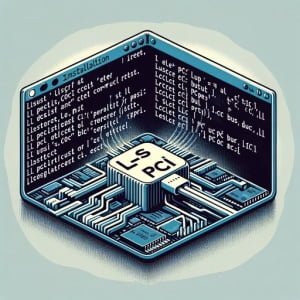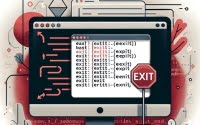Install Methods for ‘lspci’ Command | Linux User’s Guide

Are you struggling to understand your PCI buses and devices in Linux? You’re not alone. Many Linux users, especially beginners, find it challenging. But don’t worry, the ‘lspci’ command is here to help. Installing ‘lspci’ will make it easy to inspect your PCI buses and devices directly from the Linux command line. It’s available on most package management systems, making the installation process straightforward once you know the steps.
In this guide, we will walk you through the process of installing and using the ‘lspci’ command in Linux. We will cover methods for both APT and YUM-based distributions, delve into compiling ‘lspci’ from source, and installing a specific version. Finally, we will guide you on how to use the ‘lspci’ command and ensure it’s installed correctly.
So, let’s dive in and start installing ‘lspci’ on your Linux system!
TL;DR: How Do I Install and Use the ‘lspci’ Command in Linux?
In most Linux distributions, the
'lspci'command comes pre-installed, you can verify this with,lspci -v. If it is not installed, you can add it via the pciutils package and the command,sudo [yum/apt-get] install pciutils. To use it, simply typelspciin your terminal.
For more detailed information, use the -v flag, like so:
lspci -v
This command will display verbose information about your PCI devices. But there’s much more to learn about the ‘lspci’ command. Continue reading for a more detailed guide on how to use ‘lspci’ and its various options.
Table of Contents
- Understanding and Installing the ‘lspci’ Command
- Installing ‘lspci’ from Source Code
- Installing Different Versions of ‘lspci’
- Using ‘lspci’ and Verifying Installation
- Alternative Methods for Inspecting PCI Buses in Linux
- Troubleshooting ‘lspci’ Command Issues
- Understanding PCI Buses and Devices
- The Significance of Hardware Inspection in System Administration and Security
- Wrapping Up: Installing ‘lspci’ Command in Linux
Understanding and Installing the ‘lspci’ Command
The ‘lspci’ command is a utility in Linux that displays detailed information about all PCI buses and devices in your system. It’s a handy tool for system administrators and users who want to understand their system’s hardware configuration.
Installing ‘lspci’ with APT
If you’re using a Debian-based distribution like Ubuntu, you can install ‘lspci’ using the Advanced Package Tool (APT). First, update your package lists for upgrades and new package installations. Run the following command:
sudo apt-get update
After updating, install the ‘pciutils’ package, which includes the ‘lspci’ command:
sudo apt-get install pciutils
Installing ‘lspci’ with YUM
For Red Hat-based distributions like CentOS or Fedora, use the Yellowdog Updater, Modified (YUM). As with APT, first update your system with:
sudo yum update
Then, install the ‘pciutils’ package:
sudo yum install pciutils
Installing ‘lspci’ with Zypper
If you’re using an openSUSE distribution, you can use the Zypper package manager to install ‘lspci’. Update your system with the following command:
sudo zypper refresh
Then, install the ‘pciutils’ package:
sudo zypper install pciutils
In most cases, the ‘lspci’ command comes pre-installed with the Linux distribution. If you’re not sure whether ‘lspci’ is installed, you can verify it by typing lspci in your terminal. If it’s installed, you’ll see a list of all PCI devices on your system.
Installing ‘lspci’ from Source Code
For Linux users who prefer to compile their software from source code, ‘lspci’ can be installed from its source. This method offers more control over the installation process and is often used when a pre-compiled binary is not available for a specific Linux distribution.
Here’s how to install ‘lspci’ from source:
First, download the latest source code from the official website. For this example, we’ll use wget to download the tarball:
wget http://ftp.us.debian.org/debian/pool/main/p/pciutils/pciutils_3.7.0.orig.tar.xz
Next, extract the tarball file:
tar -xf pciutils_3.7.0.orig.tar.xz
Navigate to the extracted directory:
cd pciutils-3.7.0
Finally, compile and install the software:
make
sudo make install
Installing Different Versions of ‘lspci’
Different versions of ‘lspci’ may have different features or bug fixes. It’s important to install the version that best fits your needs.
Installing Specific Versions from Source
To install a specific version from source, you’ll need to download the corresponding tarball from the official website. Replace ‘3.7.0’ in the wget command with the version number you want to install.
Installing Specific Versions with Package Managers
APT
On Debian-based systems, you can install a specific version of a package using the following syntax:
sudo apt-get install pciutils=version
Replace ‘version’ with the version number you want to install.
YUM
On Red Hat-based systems, you can use the following syntax:
sudo yum install pciutils-version
Replace ‘version’ with the version number you want to install.
Version Comparison
Different versions of ‘lspci’ have different features. Here’s a comparison of some key features in recent versions:
| Version | Key Changes |
|---|---|
| 3.7.0 | Added support for new devices |
| 3.6.4 | Fixed bugs in device display |
| 3.6.2 | Improved performance |
Using ‘lspci’ and Verifying Installation
Basic Usage of ‘lspci’
Once ‘lspci’ is installed, you can use it to display information about your PCI buses and devices. Here’s an example:
lspci -nn
This command displays the names and IDs of all PCI devices.
Verifying ‘lspci’ Installation
To verify that ‘lspci’ has been installed correctly, you can use the ‘-v’ flag to display the version number:
lspci -v
If ‘lspci’ is installed correctly, this command will display the version number and other information about ‘lspci’.
Alternative Methods for Inspecting PCI Buses in Linux
While ‘lspci’ is a powerful tool for inspecting PCI buses and devices, there are other methods you can use to achieve similar results. One such command is the ‘lsusb’ command, which is used for inspecting USB buses and devices.
Using ‘lsusb’ for USB Buses
The ‘lsusb’ command lists all USB devices connected to your system. It’s similar to ‘lspci’, but it’s specifically designed for USB buses and devices. Here’s an example of how to use ‘lsusb’:
lsusb
This command will display a list of all USB devices connected to your system. Each line represents a USB device and includes information such as the bus number, device number, vendor ID, product ID, and device class.
Bus 002 Device 001: ID 1d6b:0003 Linux Foundation 3.0 root hub
Bus 001 Device 003: ID 8087:0a2b Intel Corp.
Bus 001 Device 002: ID 046d:c534 Logitech, Inc. Unifying Receiver
Bus 001 Device 001: ID 1d6b:0002 Linux Foundation 2.0 root hub
In this output, ‘Bus 002 Device 001’ is the bus number and device number. ‘ID 1d6b:0003’ is the vendor ID and product ID. ‘Linux Foundation 3.0 root hub’ is the device class.
Advantages and Disadvantages of ‘lsusb’
‘lsusb’ is a great tool for inspecting USB devices, but it has its limitations. Here are some advantages and disadvantages of ‘lsusb’:
- Advantages:
- Lists all USB devices connected to your system.
- Displays detailed information about each device.
- Easy to use.
- Disadvantages:
- Only works for USB devices.
- Does not display information about PCI devices.
Recommendations
While ‘lspci’ and ‘lsusb’ are both powerful tools, they serve different purposes. If you need to inspect PCI buses and devices, ‘lspci’ is the better choice. If you need to inspect USB devices, ‘lsusb’ is the way to go. Understanding both commands will give you a broader view of your system’s hardware configuration.
Troubleshooting ‘lspci’ Command Issues
Even though the ‘lspci’ command is relatively straightforward to use, you may encounter some issues. Here are a few common problems and their solutions.
‘lspci’ Command Not Found
If you get a ‘command not found’ error when you try to run ‘lspci’, it means that the ‘lspci’ command is not installed on your system or it’s not in your PATH. To solve this issue, install the ‘pciutils’ package as described in the ‘Installing ‘lspci” section.
sudo apt-get install pciutils
No Output from ‘lspci’ Command
If the ‘lspci’ command doesn’t produce any output, it could mean that there are no PCI devices in your system. This is unlikely in a desktop or laptop computer, but it’s possible in some embedded systems. In this case, there’s no need to use ‘lspci’.
‘lspci’ Output is Too Verbose
If you find that the output of ‘lspci’ is too verbose, you can limit the output by using various flags. For example, the ‘-t’ flag will show a tree view of the PCI buses and devices, which is more compact and easier to understand.
lspci -t
This command will display a tree view of the PCI devices.
-[0000:00]-+-00.0 Intel Corporation 8th Gen Core Processor Host Bridge/DRAM Registers
+-02.0 Intel Corporation UHD Graphics 620 (Whiskey Lake)
+-14.0 Intel Corporation Cannon Point-LP USB 3.1 xHCI Controller
+-14.2 Intel Corporation Cannon Point-LP Thermal Controller
In this output, each line represents a PCI device. The ‘+’ and ‘-‘ symbols represent the hierarchy of the devices.
Remember, the ‘lspci’ command is a powerful tool for inspecting your PCI buses and devices. Understanding its usage and how to troubleshoot common issues will help you use it more effectively.
Understanding PCI Buses and Devices
To fully grasp the ‘lspci’ command, it’s essential to understand the basics of PCI buses and devices in Linux. PCI, or Peripheral Component Interconnect, is a standard for connecting peripheral devices to a computer’s motherboard. These devices can include graphics cards, network cards, sound cards, and more.
What are PCI Buses?
In the context of computer hardware, a bus is a communication system that transfers data between different components inside a computer, or between computers. A PCI bus, therefore, is a bus that uses the PCI standard.
How Does ‘lspci’ Work?
The ‘lspci’ command reads the PCI bus for all connected devices and displays detailed information about them. It can show you the vendor ID, device ID, class ID, and more. Here’s an example of ‘lspci’ output:
lspci -nn
This command will display the names and IDs of all PCI devices.
00:00.0 Host bridge: Intel Corporation 8th Gen Core Processor Host Bridge/DRAM Registers (rev 07)
00:02.0 VGA compatible controller: Intel Corporation UHD Graphics 620 (Whiskey Lake) (rev 02)
00:14.0 USB controller: Intel Corporation Cannon Point-LP USB 3.1 xHCI Controller (rev 30)
In this output, ’00:00.0′ is the bus number and device number. ‘Host bridge’ is the class of the device. ‘Intel Corporation 8th Gen Core Processor Host Bridge/DRAM Registers (rev 07)’ is the name and version of the device.
Importance of Understanding Your System’s Hardware
Knowing your system’s hardware configuration is crucial for troubleshooting and optimization. For instance, if you’re experiencing issues with your graphics card, you can use ‘lspci’ to check its model and manufacturer. This information can help you find the right drivers or identify known issues with your hardware.
Furthermore, understanding the ‘lspci’ command and its output can provide valuable insights into your system’s performance. It can show you how your hardware is connected, which can help you optimize your system for better performance.
The Significance of Hardware Inspection in System Administration and Security
Understanding your system’s hardware is more than just a quest for knowledge. It plays a critical role in system administration and security. By knowing what hardware your system is running on, you can optimize its performance, troubleshoot issues, and secure it against potential vulnerabilities.
Exploring Related Concepts: USB Buses and Device Drivers
While ‘lspci’ allows you to inspect PCI buses and devices, there’s a lot more to explore in the Linux hardware landscape. For instance, the ‘lsusb’ command lets you inspect USB buses and devices, providing a similar functionality to ‘lspci’ but for USB devices. Here’s an example of how to use ‘lsusb’:
lsusb -v
This command will display verbose information about your USB devices.
Bus 002 Device 001: ID 1d6b:0003 Linux Foundation 3.0 root hub
Device Descriptor:
bLength 18
bDescriptorType 1
bcdUSB 3.00
bDeviceClass 9 Hub
bDeviceSubClass 0 Unused
In this output, ‘Bus 002 Device 001’ is the bus number and device number. ‘ID 1d6b:0003’ is the vendor ID and product ID. ‘Linux Foundation 3.0 root hub’ is the device class.
Device drivers are another important aspect of Linux hardware. These are essentially software that allows your operating system to communicate with your hardware. You can use commands like ‘lshw’ to display information about your system’s hardware and the drivers they’re using.
Further Resources for Linux Hardware Mastery
If you’re interested in diving deeper into Linux hardware, here are some resources to check out:
- Linux Hardware Guide: A comprehensive guide to Linux-compatible hardware.
Linux Command Library: A library of Linux commands, including hardware-related commands like ‘lspci’, ‘lsusb’, and ‘lshw’.
Linux Driver Tutorial: A tutorial on how to write your own Linux drivers.
Wrapping Up: Installing ‘lspci’ Command in Linux
In this comprehensive guide, we’ve explored the ‘lspci’ command in Linux, a powerful tool to inspect your system’s PCI buses and devices. We’ve seen how to install ‘lspci’ using different package managers, compile it from source code, and even install specific versions based on your needs.
We began with the basics, learning how to install the ‘lspci’ command using different package managers such as APT, YUM, and Zypper. We then delved into more advanced topics, such as installing ‘lspci’ from source code and installing specific versions of ‘lspci’. We also discussed how to use the ‘lspci’ command to display information about your PCI buses and devices.
Throughout the guide, we tackled common issues you might face when using the ‘lspci’ command, providing solutions for each problem. We also looked at alternative methods for inspecting your system’s hardware, such as the ‘lsusb’ command for USB devices.
Here’s a quick comparison of the methods we’ve discussed:
| Method | Versatility | Ease of Use |
|---|---|---|
| ‘lspci’ | High | High |
| ‘lsusb’ | Moderate | High |
Whether you’re a beginner just starting out with Linux or an experienced system administrator, we hope this guide has helped you better understand the ‘lspci’ command and its capabilities. With the ability to inspect your system’s PCI buses and devices, you’re now equipped with a powerful tool to optimize your system’s performance and troubleshoot hardware-related issues. Happy exploring!


